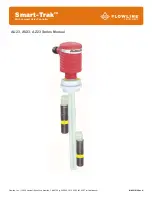
LM900006 Rev 0_3
11
|
Electrical (continued)
Step
Five
AUTOMATIC FILL:
This system consists of a tank with a high and low level sensor, and a pump or
valve that is operated by the controller. Proper fail-safe design for this system is to
stop filling if power is lost. Therefore, we connect the pump/valve to the NO side of
the relay. When energized, the device will activate and fill the tank. The relay LED
will correspond directly to the ON/OFF status of the pump/valve.
NOTE: If the
pump motor load exceeds the rating of relay controller, a stepper relay of higher
capacity must be used as part of the system design.
Determining the settings of LATCH and INVERT:
This is the way the system
must operate:
When both the high and low sensors are dry, the device should activate, starting to fill the tank.
When the low sensor gets wet, the device should stay ON.
When the high sensor gets wet, the device should turn OFF.
Latch:
In any two-sensor control system, LATCH must be ON.
Invert:
Referring to the logic chart in Step Nine, we look for the setting that will de-energize the relay (start the
pump) when both inputs are wet (Amber LEDs).
In this system, Invert should be ON
.
AUTOMATIC EMPTY:
Note that similar system logic can be used for an automatic empty operation simply
by controlling a pump/valve that takes fluid out of the tank instead of into it.
Connect the pump/valve to the NO side of the relay. When energized, the device
will activate and empty the tank.
Determining the settings of LATCH and INVERT:
This is the way the system
must operate:
When both the high and low sensors are wet, the device should activate,
starting to empty the tank.
When the high sensor gets dry, the device should stay ON.
When the low sensor gets dry, the device should turn OFF.
Latch:
In any two-sensor control system, LATCH must be ON.
Invert:
Referring to the logic chart in Step Nine, we look for the setting that will de-energize the relay (start the
pump) when both inputs are wet (Amber LEDs).
In this system, Invert should be OFF
.




















